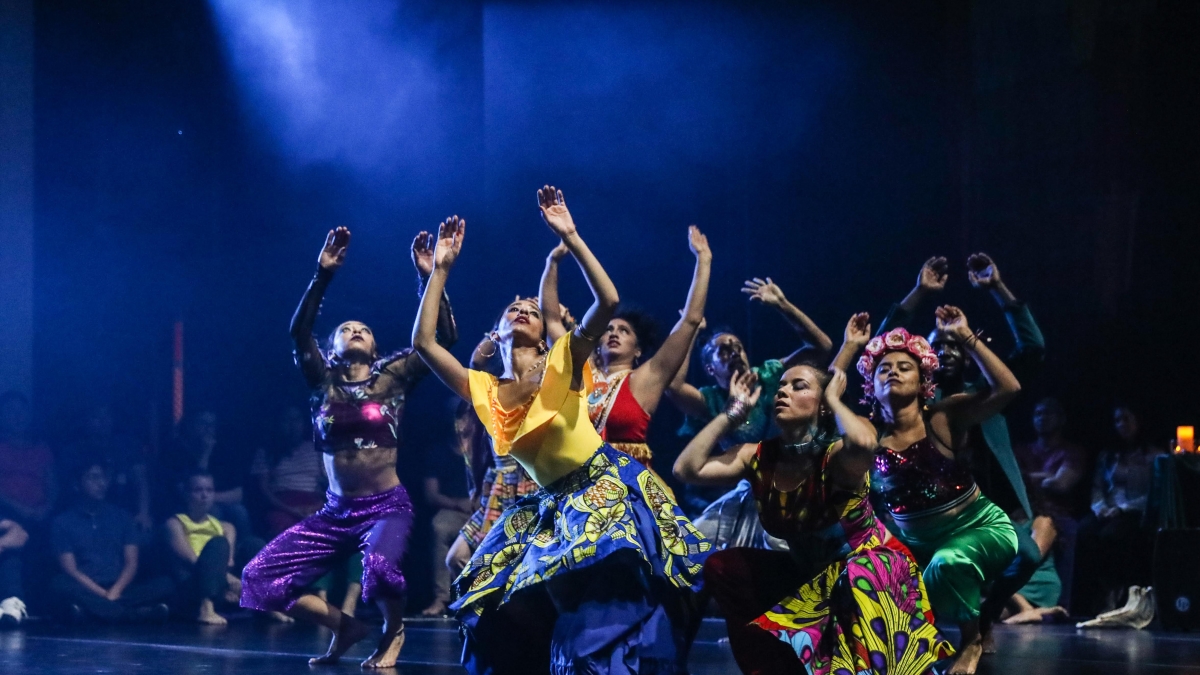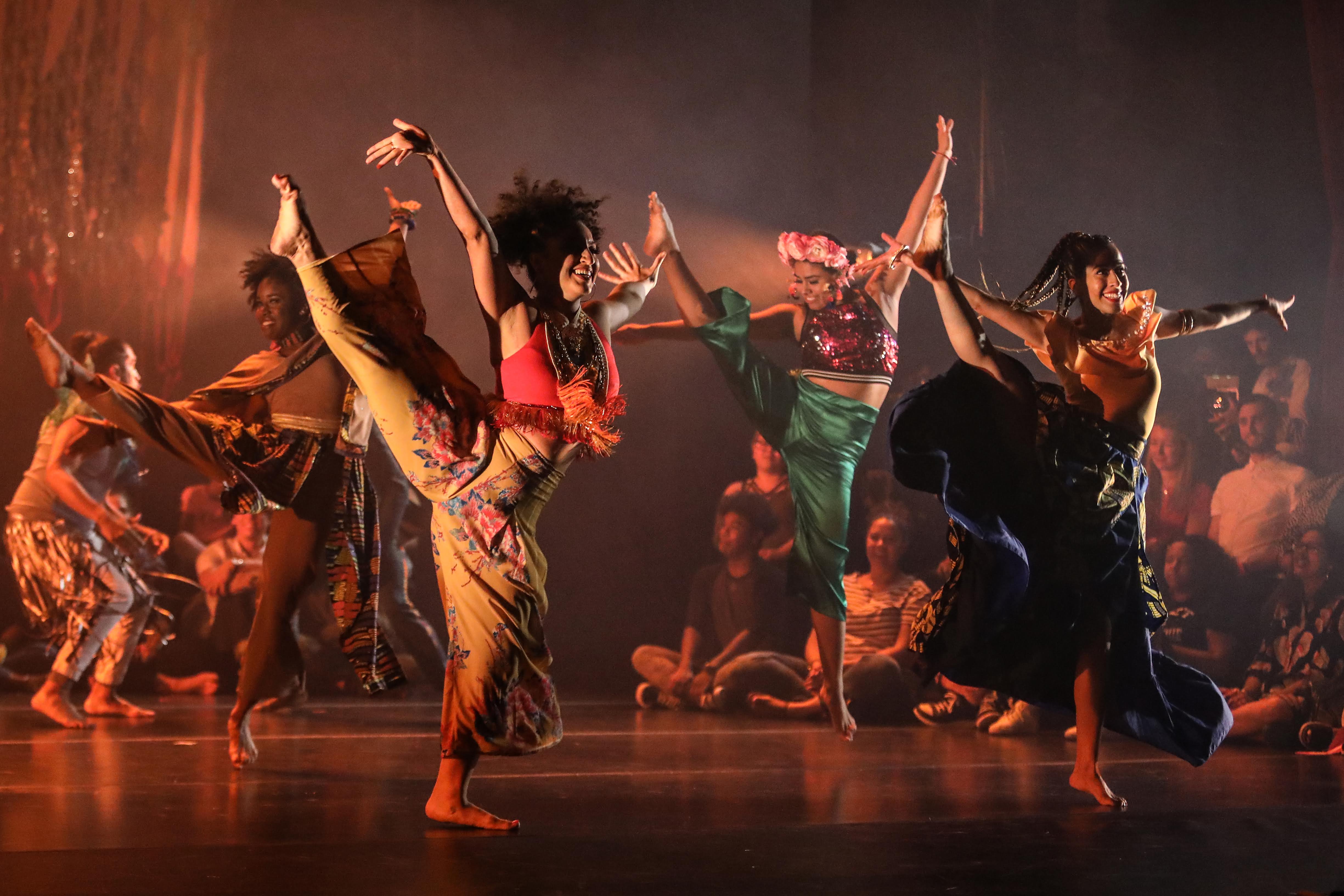A conversation with Contra-Tiempo’s founding artistic director Ana Maria Alvarez

"joyUS justUS" is an urban Latin dance theater experience coming to ASU Gammage Feb. 15.
Dance company Contra-Tiempo's "joyUS justUS" is an urban Latin dance theater experience coming to ASU Gammage Feb. 15. Here, the troupe's founding artistic director, Ana Maria Alvarez, gives unique insight to the the process behind the show. Purchase tickets.
Question: What inspired you to create "joyUS justUS"?
Answer: I had a dream about creating an epic piece that centered around joy — and not just joy as in happiness, but as this profound birthright — the thing we are all really fighting for! I had no idea what it would look like, I just knew that the next piece we created needed to center around joy, radical joy! We began a partnership with a community coalition, a 30-year-old advocacy organization in southern Los Angeles, and began a weekly practice of community “Get Downs,” or “Sabor Sessions,” where we practiced joy like a muscle — even when it felt hard. Out of these sessions came the journey of questions: What is radical joy? How can joy be a powerful tool, or even a weapon, to build a more loving and just society? What can be done with a culture that treats joy as a commodity or a privilege and how can we reclaim joy as a birthright? How can that image reframe and reimagine our future?
Q: Contra-Tiempo is set apart by its unique relationship to its own community. Can you describe that relationship and how it informs the work of the company?
A: Contra-Tiempo itself is a tapestry, much like the communities we reach. Our company members are professional dancers, artists, immigrants, educators, activists, organizers and movers of all types. Our company members live and work in Los Angeles and across the country. Each company member lives, expresses and struggles within the infinitely complex political and personal landscapes that we address in our work. We are committed to building our work not inside a vacuum, but inside of meaningful relationships that take time and consistency. Through our regular choreographic labs, we invite community members to feedback sessions to generate ideas and question the work as it develops. This creates communal relationships that feed and are fed by the creative process.
Q: Can you describe your process working with dancers? Is there a collaboration process?
A: Absolutely. For me, choreography is the writing of bodies. It isn't about a singular vision. I have strong and very clear ideas of where I want to go, but I work consistently to empower my dancers to find their voices during the process. A successful choreographic work is one where each dancer has at least one moment of truth. I use improvisation and play with the process to uncover those truths. Sometimes, I build the blocks by teaching phrase work, and other times I ask the dancers to generate the building blocks based on their own ideas of the work. I deeply trust the artists I work with, and I respect their craft, contributions and ideas. I also trust my own instincts and craft. I feel like a lot of my choreographic style is like a community of movement. When I feel strongly about something, I go with it and I don’t allow someone else to ruin it. That doesn’t mean I use everything contributed, but it’s something that I’ve come to love about the creative process. It’s a space of generating and actualizing ideas for me, but it’s also a space of organizing, facilitating, encouraging and curating ideas. I feel like our best work emerges when these are not pitted against one another and egos can be left at the door. When we see what is generated as something bigger than just one idea, then the magic happens.
Contra-Tiempo returns to ASU Gammage on Saturday, Feb. 15, with "joyUS justUS" with live music by Las Cafeteras. Tickets are on sale now at asugammage.com.
Q: What do you hope the audience leaves with after seeing "joyUS justUS"?
A: I hope they leave with a renewed hope in humanity and a belief in our collective future. I want them to feel a deep affirmation of how critical connection is and a willingness to rise in the fight for justice and joy. I hope they leave fired up and willing to engage.
Q: What are you looking forward to most about returning to ASU Gammage and Tempe?
A: Our last performance at ASU Gammage was in 2016, just after Donald Trump was elected as president. We were pretty devastated. It was an incredible residency and we made some strong connections that we are very excited to continue to build, but it was an intense time to be in Arizona. I met some incredible contacts through our residency with ASU Gammage, contacts that have brought me back to work with other artists, activists and communities through the Binational Arts Residency program. We now also have an ASU alumna who is touring with us, Ruby Morales. The relationships we built in Tempe and Phoenix have developed into our community cast and community altar of local performers and participants. It will be incredible! In many ways ASU feels like a home away from home. Having Las Cafeteras perform with us there, I’m imagining this show will feel similar to the magic we feel when we perform for Los Angeles audiences!
Q: A huge part of our work at ASU Gammage is working with ASU students. What advice do you have for college students who aspire to be professional artists?
A: Decide what you want to do and then reach out to folks doing that very thing. Ask them to meet with you, ask questions, find excuses to work with them or others like them, don’t go about it alone. Mentorship, partnership and connection is at the root of our success and joy!
More Arts, humanities and education

ASU professor’s award-winning book allows her to launch scholarship for children of female shrimp traders in Mexico
When Arizona State University Associate Professor Maria Cruz-Torres set out to conduct the fieldwork for her third book, "Pink…

Herberger Institute Professor Liz Lerman to be honored as Dance Magazine Award winner
Dance Magazine has announced that Arizona State University Herberger Institute Professor Liz Lerman will be honored as a…
AI literacy course prepares ASU students to set cultural norms for new technology
As the use of artificial intelligence spreads rapidly to every discipline at Arizona State University, it’s essential for…
